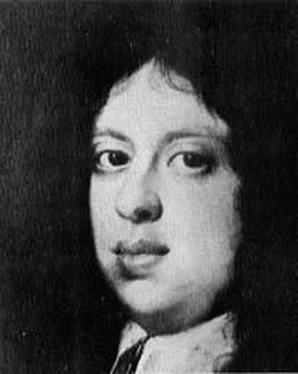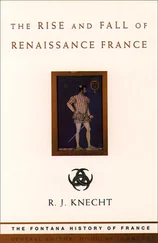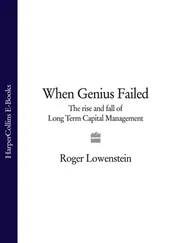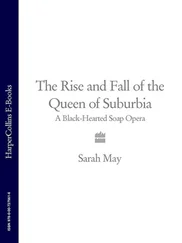So ambitious a project needed extremely tactful handling. He must not appear too eager; nor must he act without the consent of the Emperor. He played his part extremely well. The Venetian ambassador, for one, was not at all convinced that the Pope had made up his mind about the match; while the Emperor evidently thought it so unlikely that the French court would agree to it that, when the Pope travelled to Bologna to seek his permission, Charles gave way as though it were a matter of not very much importance. To the Emperor’s surprise, however, the French were not at all averse to the match. And so it was that on 28 October 1533, the Pope himself conducting the ceremony in Marseilles, the fourteen-year-old Caterina de’ Medici, Duchess of Urbino, was married to Henri de Valois, Duke of Orleans, second son of Francis I.
It was Clement’s last triumph. Already ill when he began his journey to Marseilles, accompanied by those lavish wedding gifts for which the taxpayers of Rome and Florence had yet to pay, he returned to the Vatican a dying man. He was pitiably thin and shrunken; he was almost blind in his right eye, which had always had a slight squint; his liver was diseased and his skin was consequently pale and yellowish. Exasperating problems faced him on every side: there was the quarrel with England over the supremacy of the Holy See; there was the growing enmity of the Emperor who, irritated by the recent Medici marriage, was making renewed demands for a General Council of the Church; there were – vexatious above all – the persistent quarrels between Ippolito and Alessandro and the danger that between them they would be responsible for their family losing Florence once again.
When Benvenuto Cellini went to see the Pope on 22 September 1534 to show him some models he had designed for him, he found him in bed and failing fast.
He ordered his spectacles and a candle to be brought, but nevertheless he could discern nothing of my workmanship. So he set to examine the models by the touch of his fingers, but after feeling thus for some length of time he fetched a deep sigh, and told one of the courtiers that he was sorry for me, but if it pleased God to restore his health, he would make me a satisfactory payment. Three days later he died.
Cellini confessed that the tears filled his eyes as he kissed the dead Pope’s feet; but there was no one else to mourn for him. On the contrary, Rome rejoiced. As Francesco Vettori said of him, he had gone ‘to a great deal of trouble to develop from a great and respected cardinal into a small and little respected Pope’. Night after night St Peter’s was broken into; the corpse was transfixed by a sword; the temporary tomb was smeared with dirt; and the inscription beneath it, ‘ Clemens Pontifex Maximus ’, was obliterated and in its place were written the words, ‘ Inclemens Pontifex Minimus ’. 3
The news from Rome was received in Florence with glum foreboding. It was felt that, following the death of the Pope whom many supposed to be his father, Alessandro de’ Medici would impatiently throw off all restraint and institute that tyrannical government to which his own tastes seemed naturally inclined. So far he had behaved quite circumspectly. Nine months after his ceremonial entry into the city, he had been proclaimed hereditary Duke; but, so as to allay the outrage to republican susceptibilities which this proclamation caused, he was at the same time required to consult various councils of Florentine citizens and to heed their advice. For a time he had done so; the people had been gradually reassured; and it was grudgingly allowed that, ill-favoured and rude as he was, there might, when he grew older, be discovered some good in Alessandro after all.
The Pope’s death brought all the old fears back, and before that winter was over they were seen to be justified. Even the pretence of consultation with the elected councils was abandoned as Alessandro indulged his young fancy for authoritarian rule and became ever more blatant in his sexual escapades. He outraged the citizens by having the great bell in the Palazzo della Signoria – which had been smashed in the Piazza to symbolize the death of the Republic – melted down and recast into medals glorifying his family; by having his coat-of-arms carved over the gateway of the recently enlarged fort at the Porta alla Giustizia; 4by impounding all weapons, even those hung as votive offerings in the churches; and by building a huge new fortress, the Fortezza da Basso, 5‘a thing totally inappropriate to a free city, as the examples of Venice, Siena, Lucca and Genoa clearly show’. There was murmured talk of tyrannicide; but the memory of the recent long siege was still fresh in men’s minds, and the dissidents hung back from so violent a solution to their plight which might bring another imperial army to the gates of the city. For a time it was hoped that the jealous Ippolito might settle the Florentines’ problems for them; and Ippolito did, indeed, agree to present a case against Alessandro at Charles V’s court; but before he was able to do so he died on 10 August 1535 at Itri, either of malaria or of poisoning. His body was carried back to Rome by the handsome athletes – Moors, Tartars, Turks, Negro wrestlers and Indian divers – with whom it had been his extravagant fancy to go out upon his travels.
The leading Florentine exiles then presented themselves to the Emperor with a long list of complaints against Alessandro. Their spokesman, Jacopo Nardi the historian, gave a horrifying account of the Duke’s misdeeds and of the miseries of Florence now being overawed by a ‘great fortress, built with the blood of her unhappy people as a prison and slaughter-house for the unhappy citizens’. But although the Emperor promised ‘to do what was just’, he preferred to set less store by Nardi’s charges than by the extremely cunning and wholly inaccurate rebuttal of them by Alessandro’s chief adviser, Francesco Guicciardini, who went so far as to conclude his peroration with the words, ‘One cannot reply in detail to the charges about women, rape and similar calumnies uttered in general; but His Excellency’s virtue, his fame, the opinion of him held throughout the city, of his prudence, of his virtuous habits, are a sufficient reply.’
Thus assured of the excellent qualities of his prospective son-in-law, the Emperor declined to accept the exiles’ charges. Alessandro’s marriage to the fourteen-year-old Margaret accordingly took place, and the Duke returned to Florence in firmer control of the city than ever and evidently anxious to make the most of his good fortune. Within a few months, though, he was dead.
There had arrived in Florence a thin, plain, sad-faced young man of eccentric habits and unwholesome reputation, Lorenzaccio de’ Medici, son of Pierfrancesco and cousin of Giovanni delle Bande Nere. He had spent much of the past few years in Rome, but his habit of slashing off the heads of antique statues when drunk had led to his being asked to leave and to his coming to Florence where he had become a constant companion of his kinsman, Alessandro, who was just three yean older. Together they went out drinking and whoring; they indulged a mutual taste for disguising themselves as women; they galloped through the streets on the same horse, shouting insults at the passers-by; sometimes they shared the same bed. Alessandro was obviously fond of Lorenzaccio, though he seems not to have known what to make of him. Intrigued by his mysterious smile and subtle, ambivalent remarks, he nicknamed him ‘the philosopher’. But it was equally clear that Lorenzaccio did not really like Alessandro, that he resented his power and rank, that he fancied himself in the role of hero, in any role, in fact, that would bring him fame or even notoriety. The role in which he eventually decided to cast himself was that of tyrannicide.
Читать дальше












